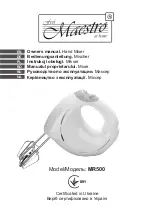
9- TAPE IN
Use the Tape input to connect a CD Player, Tape, DAT, iPOD or any other line-level
source. You can send this signal either to CONTROL ROOM OUTPUT and/or to the
MAIN MIX OUTPUT using the relative 2TK TO select buttons.
10- TAPE OUT
These RCA jacks will route the main mix signal into a tape or DAT recorder.
CHANNEL STRIP
3-BAND EQ
You have three EQ control for each mono and stereo input channel each
pro/-15 dB of boost and cut (MID is +/-12 dB). The signal will be
unaffected when the controls are on center position.
You may use an external equalizer to make up a mix properly but a master
equalizer will not have effect on a single channel and you may overload the
signal easily. Individual EQ will give you a much better control on single tracks.
11- HI
If you turn this control up, you will boost all the frequencies above 12 kHz
(shelving filter). You will add transparency to vocals & guitar and also make
cymbals crispier. Turn the control down to cut all frequencies above 12 kHz. In
such way, you can reduce sibilances of human voice or reduce the hiss of a Tape
player.
12- MID
This is a peaking filter and it will boost/cuts frequencies with their center at 2.5
kHz. This control will affect especially upper male and lower female vocal ranges
and also the harmonics of most musical instruments.
13- LOW
If you turn this control up, you will boost all frequencies below 80 Hz. You will give more punch to bass
drums and bass guitar; and you will make the male vocalist more "macho". Turn it down and you will cut all
the frequencies below 80 Hz. In this way you can avoid low-frequency vibrations and resonance thus
preserving the life of your woofers.
14- AUX SEND
This control is used to adjust the level of the signal sent to AUX SENDS output (if nothing is connected to
AUX SEND socket, the signal will be sent to the resident digital multi-effect), and such adjustment doesn't
affect the main mix output signal at all. AUX is configured as POST fader, however, it can also be configured
as PRE fader through internal modification. (For more detail, please refer to chapter 6)
15- PAN/BAL
This is the PANORAMA control, or balance control. You can adjust the stereo image of the signal via this
control. Keep this control in center position and your signal will be positioned in middle of stage. Turn this
control fully counter clockwise and the signal will be present only on the left speaker and vice-versa. Of
course a large number of intermediate positions is available.
16- PEAK LED
This red LED will let you know about the status of the signals processed into MXi.6FX . Connect a
microphone or an instrument to MXi.6FX and sing/play at normal volume. Set the level control of that
channel so that the PEAK LED lights-up only occasionally. If this LED is always on, you are experiencing a lot
of distortion and you should turn the TRIM control down or reduce the EQ boosting. If this led never lights
up, turn the TRIM control up again.
17- LEVEL
This knob controls the channel's level from -∞ to +15 dB.
Summary of Contents for MXI Series
Page 1: ...MXi 6FX ...
Page 2: ......
Page 5: ...Hookup Diagram ...
Page 10: ...Wire Connections ...
Page 11: ...Block Diagram ...
Page 12: ...Preset List ...
Page 13: ...MXi 6FX MIXING CONSOLE Technical Specification ...
Page 14: ......
Page 15: ......
Page 16: ......
Page 17: ......
Page 18: ......
Page 19: ......
Page 20: ......
Page 21: ...MXi 6FX ...
Page 22: ...MXi 6FX ...
Page 23: ...MXi 6FX ...
Page 24: ......
Page 25: ......
Page 26: ......
Page 27: ......
Page 28: ...MXi 6FX ...
Page 29: ......
Page 30: ...NF05176 1 0 ...








































